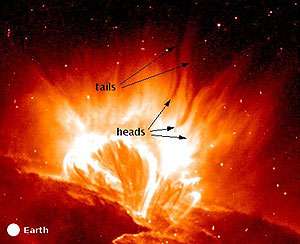Solar Tadpoles Wave at Astrophysicists

Researchers at the University of Warwick's Department of Physics have gained insight into the mysterious giant dark "tadpoles" that appear to swim towards the surface of the Sun during solar flares - enormous energy releases happening in the atmosphere of the Sun.
The tadpoles - colossal physical structures with dark heads and attendant wiggly tails that seem to swim sunwards against tides of hot matter being thrown away from the Sun during flares - have puzzled astrophysicists for several years, as they are so unlike any other phenomena observed on the Sun.
University of Warwick researchers Dr Valery Nakariakov and Dr Erwin Verwichte believe they have managed to understand the physics of this process. They analysed observations obtained with NASA's "Transition Region And Coronal Explorer" (TRACE) space mission and put forward the idea that the wiggles of the tadpoles' tails are huge waves - similar to the flying of flags in the wind - though, these solar wiggles are several times larger than the Earth. The scientists think that the waves are produced by a peculiar physical mechanism known as "negative energy waves", when waves suck energy from the medium they propagate through.
The understanding of the wiggles allowed the researchers to conclude that the tadpoles themselves are not material features, but optical illusions, as the solar matter is not falling down but is being continuously thrown upwards. The apparently descending tadpole head marks the falling start point of the matter's upward acceleration
This work has just been published this month as a Letter in Astronomy and Astrophysics.
An animation of the tadpoles can be seen here:
tbird5.astro.warwick.ac.uk/~erwin/Tadpole_movie
Source: University of Warwick

















